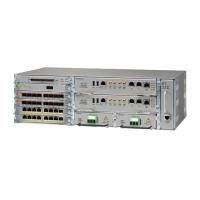4
Cisco IOS XE 3S Release Notes for the Cisco ASR 903 Router
OL-26630-08
Chapter
New Software Features in Cisco IOS XE Release 3.7(0)S
–
http://www.cisco.com/en/US/docs/ios/12_0s/feature/guide/fspseudo.html
–
http://www.cisco.com/en/US/partner/docs/ios/mpls/configuration/guide/mp_hspw_for_atm.html
#wp1054150
• Hybrid Clocking Support—Hybrid clocking mode that uses clock frequency obtained from the
synchronous Ethernet port while using phase (ToD or 1PPS) obtained using PTP. The combination
of multiple time and phase sources for the same master clock improves performance over using PTP
alone. The router can act as a hybrid clock in both master ordinary clock and slave ordinary clock.
For more information, see
http://www.cisco.com/en/US/docs/routers/asr903/software/guide/chassis/Release3.7.0S/ASR903-
Chassis-SW-37.html.
• IPv6 ACL—IPv6 Access Control Lists (ACLs) determine what traffic is blocked and what traffic is
forwarded at device interfaces. ACLs allow filtering based on source and destination addresses,
inbound and outbound to a specific interface. For more information, see
http://www.cisco.com/en/US/docs/wireless/asr_900/feature/guides/IPv6_ACL.html.
• Layer 2 QoS for ATM—This feature introduces support for support cbr and vbr on ATM interfaces.
For more information, see
http://www.cisco.com/en/US/partner/docs/ios-xml/ios/mp_l2_vpns/configuration/xe-3s/qos-atm-v
p-support-xe.html
• Link Path Through—This feature enables a local EoMPLS PE router to detect a failure in the path
between the remote PE and CE routers. The local PE router propagates the failure to the local CE
router such that it brings down the pseudowire connection and can more quickly reestablish the
connection when the remote CE-PE connection is restored. This feature is enabled automatically and
does not introduce any new CLI commands.
• MAC Address Security for EVC Bridge-Domain—MAC address security for EVCs. Provides the
capability to control and filter the MAC address learning behavior at the granularity of a single EVC
service instance. For more information, see:
–
http://www.cisco.com/en/US/docs/ios-xml/ios/cether/configuration/xe-3s/asr903/ce-mac-addlmt
-bdsin.html
–
http://www.cisco.com/en/US/docs/ios-xml/ios/cether/configuration/xe-3s/ce-mac-addlmt-bdsin.
html
• MAC Limiting—Mac address limiting per bridge-domain restricts the number of MAC addresses
that the router learns in bridge-domain on an EFP, pseudowire or switch port. For more information,
see http://www.cisco.com/en/US/docs/wireless/asr_900/feature/guides/mac_limiting.html.
• MPLS VPN—The MPLS VPN Inter-AS with ASBRs Exchanging VPN-IPv4 Addresses feature
allows a Multiprotocol Label Switching (MPLS) Virtual Private Network (VPN) to span service
providers and autonomous systems. For more information, see
http://www.cisco.com/en/US/docs/ios/mpls/configuration/guide/mp_vpn_connect_asbr.html.
• Multicast Static MAC Addresses— Static MAC addresses allow you to enable multicast at the layer
2 level. You can use multicast static MAC addresses to forward multicast packets to specific EFPs
on a network. For more information, see
http://www.cisco.com/en/US/docs/wireless/asr_900/feature/guides/evc.html.
• Multi-Level Priority Queues (MPQ)—This feature allows you to configure multiple priority queues
for multiple traffic classes by specifying a different priority level for each of the traffic classes in a
single service policy map. You can configure multiple service policy maps per router. Having
multiple priority queues enables the router to place delay-sensitive traffic (for example, voice) on
the outbound link before delay-insensitive traffic. As a result, high-priority traffic receives the
lowest latency possible on the router. For more information, see:

